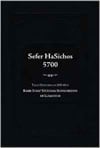Born1 12 Tammuz, 5640 (1880), in Lubavitch. In 5655 (1895), at age 15, he began his active involvement in communal affairs. On 13 Elul, 5657 (1897), he married Rebbitzin Nechamah Dinah, daughter of the saintly chassid, R. Avraham. In 5658 (1897) he was appointed director of the Tomchei Temimim Yeshivah. In 5666 (1906) he traveled abroad and brought about pressure from various circles to quell the anti-Semitic pogroms in Russia. Between 5662 (1902) and 5671 (1911) he was arrested four times in Moscow and Petersburg on account of his activities for the public good. In 5680 (1920), after the passing of his father, the Rebbe Rashab,2 on Motzaei Shabbos Kodesh, 2 Nissan, he succeeded to the nesius of Chabad chassidim. In 5681 (1921) he organized a countrywide network of activists to strengthen the study and observance of Torah throughout Russia, and founded a branch of the Tomchei Temimim Yeshivah in Warsaw. In 5684 (1924), due to the informers of the Yevsektsia,3 he was forced by the Cheka4 to leave Rostov, where he had lived [since 1915], and settled in Petersburg. There he worked to buttress the study of Torah and Jewish observance – by establishing schools and yeshivos, training rabbanim and ritual slaughterers, dispatching Torah teachers, and establishing mikvaos. He set up a special committee to help those employed in manual labor to observe Shabbos, and founded the Agudas Chassidei Chabad5 of America and Canada. In 5687 (1927) he founded yeshivos in Bukhara.
On 15 Sivan of that year, due to the informers of the Yevsektsia, he was arrested for his activities in the cause of Torah and Yiddishkeit. On 3 Tammuz he was exiled to Kostrama, but was released on 12-13 Tammuz. In 5688 (1927) he settled in Riga (then the capital of Latvia), where he established a yeshivah. In 5689-5690 (1929-1930) he visited Eretz Yisrael for the first time and from there proceeded to America. In 5694 (1934) he settled in Poland, first in Warsaw and later in Otvotzk. He founded Igud HaTemimim6 and branches of the Tomchei Temimim Yeshivah in various Polish towns. In 5695 (1935) he began to publish the journal entitled HaTamim. In 5699 (1939) he founded the international Agudas Chassidei Chabad.
On 9 Adar Sheni, 5700 (1940), he arrived in New York and settled there, and campaigned to rescue those of his students who had remained in Russia. He established the Central Tomchei Temimim Yeshivah [in Brooklyn]. In 5701 (1941), the monthly journal entitled HaKeriah VehaKedushah began to appear, and he established the Machne Yisrael society to further the cause of Torah, avodah and gemilus chassadim. In 5702 (1942) he founded the Kehot Publication Society (“Kehot” being an acronym for Karnei Hod Torah), Lubavitch. In the same year he founded: Merkos L’Inyonei Chinuch; a branch of the Tomchei Temimim Yeshivah in Canada; girls’ schools called Beis Rivkah and Beis Sarah, and branches of the [junior] Achei Temimim Yeshivah in various American provincial towns; and initiated programs for the welfare of Jewish soldiers serving in the American armed forces. In 5703 (1943) he established Sifriyas Otzar HaChassidim Lubavitch. In 5704 (1944) he published the first issue of Kovetz Lubavitch, founded the Bikur Cholim (sick-visiting) Society, and the Nicho’ach society (for the publication of Chabad niggunim). In 5705 (1945) he founded the Adino Society [for the promotion of advanced Torah scholarship],7 and the Vaad Merkazi LeEzrah LiYehudei Europa (i.e., the Central Committee to Aid European Jewry), which maintained a branch in Paris. In the same year he founded Shelah (an acronym for Shiurei Limud Torah), which provided regular sessions of religious education for Jewish children in public schools, and initiated a program designed to upgrade the spiritual condition of American Jewish farmers.
12-13 Tammuz, 5705 (1945), saw the worldwide celebration of the Rebbe’s threefold anniversary: fifty years of public activity; twenty-five years as the Nasi of Chabad chassidim; and eighteen years since he was liberated from incarceration for his dedicated labors for the buttressing of Torah study and the practice of Yiddishkeit. At that time, work was begun on the task of assembling his maamarim, letters, talks and so forth, and preparing them for publication in an anniversary edition. The present volume of sichos is a part of that project.
[In 5708 (1948)] he founded the Safariya Chabad village (i.e., Kfar Chabad) near Tel Aviv in the Holy Land, for the refugees from Russia. In 5709 (1949) he sparked the establishment of a committee to rescue the Torah education of the children in the migrants’ transit camps in the Holy Land.
In the weeks before his passing in 5710 (1950) he planned the educational groundwork for the cultivation of Torah study in the countries of North Africa, from which sprouted men’s and women’s seminaries for teachers; yeshivos; and Talmud Torah schools for boys and girls. All of these institutions carry the name, Ohalei Yosef Yitzchak – Lubavitch.
* * *
On Shabbos Kodesh Parshas Bo, Yud Shvat, 5710 (1950), at 8:00 AM, he passed away, and his resting place is in New York.
May the memory of the holy tzaddik serve as a blessing, in the life of the World to Come. His soul is in the hidden places On High. May his merit protect us and the entire Jewish people. And speedily, in our days, may we be found worthy of beholding the long-hoped-for destined time, when “those who repose in the dust will awaken and sing joyful praises,”8 and he will be among them. Amen. May this be G‑d’s Will.





